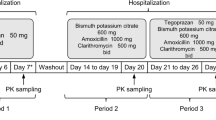Summary
The pharmacokinetics of antipyrine in plasma and saliva, and urinary excretion of its major metabolites, were studied following i.v. and oral administration of antipyrine 500 mg to 6 healthy volunteers. Data from both plasma and saliva showed that the oral bioavailability of antipyrine given as an aqueous solution was complete. The saliva/plasma concentration ratio was constant with time from about 3 h onwards, with a mean value of 0.87 after oral and 0.91 after i.v. administration. It is concluded that the pharmacokinetic parameters of antipyrine can be satisfactorily established on the basis of salivary data, although the volume of distribution and clearance values are then slightly too high. After i.v. administration, 3.8±1.9% of the dose was excreted in urine as unchanged antipyrine in 48h, 24.9±6.3% as 4-hydroxyantipyrine, 16.5±3.2% as norantipyrine, 13.0±2.2% as 3-hydroxymethyl-antipyrine and 5.8±1.0% as 3-carboxy-antipyrine. No significant differences were observed following oral administration. The half-lives calculated from the linear part of the urinary excretion rate curves of the metabolites were about the same for oral and i.v. administration, and were of the same order of magnitude as the elimination half-life of parent drug in plasma and saliva. It is important for determination of the ultimate metabolite ratio that urine is collected for at least 36h, because there is a delay in the excretion of 3-hydroxymethyl-antipyrine in urine.
Similar content being viewed by others
References
Andreasen PB, Vesell ES (1974) Comparison of plasma levels of antipyrine, tolbutamide and warfarin after oral and intravenous administration. Clin Pharmacol Ther 16: 1059–1065
Bässmann H, Böttcher J, Schüppel R (1979) Dihydroxyphenazone as an urinary metabolite of phenazone in different species including man. Naunyn Schmiedeberg's Arch Pharmacol 509: 203–205
Baty JD, Price Evans DA (1973) Norphenazone, a new metabolite of phenazone in human urine. J Pharm Pharmacol 25: 83–84
Brodie BB, Axelrod J (1950) The fate of antipyrine in man. J Pharmacol Exp Ther 98: 97–104
Chang RL, Wood AW, Dixon WR, Conney AH, Anderson KE, Eiseman J, Alvares AP (1976) Antipyrine: radioimmunoassay in plasma and saliva following administration of a high dose and a low dose. Clin Pharmacol Ther 20: 219–226
Danhof M (1979) De bepaling van het farmaconmetaboliserend vermogen bij de mens. Pharm Weekbl 114: 129–149
Danhof M (1980) Antipyrine metabolite profile as a tool in the assessment of the activity of different drug oxidizing enzymes in man. Ph D Thesis, University of Leiden, The Netherlands
Danhof M, Breimer DD (1978) Therapeutic drug monitoring in saliva. Clin Pharmacokinet 3: 39–57
Danhof M, Breimer DD (1979) Studies on the different metabolic pathways of antipyrine in man. I. Oral administration of 250, 500 and 1000mg to healthy volunteers. Br J Clin Pharmacol 8: 529–537
Danhof M, Krom DP, Breimer DD (1979a) Studies of the different metabolic pathways of antipyrine in rats: influence of phenobarbital and 3-methylcholanthrene treatment. Xenobiotica 9: 695–702
Danhof M, De Groot-van der Vis E, Breimer DD (1979b) Assay of antipyrine and its primary metabolites in plasma, saliva and urine by HPLC, and some preliminary results in man. Pharmacology 18: 210–223
Danhof M, De Boer AG, De Groot-van der Vis E, Breimer DD (1979c) Assay of 3-carboxy-antipyrine in urine by capillary gas chromatography with nitrogen selective detection; some preliminary results in man. Pharmacology 19: 215–220
Greisen G, Andreasen PB (1976) Two compartment analysis of plasma elimination of phenazone in normals and in patients with cirrhosis of the liver. Acta Pharmacol Toxicol 38: 49–58
Huffman DH, Schoeman DW, Azarnoff DL (1974) Correlation of the plasma elimination of antipyrine and the appearance of 4-hydroxy-antipyrine in the urine of man. Biochem Pharmacol 23: 197–201
Knorr L, Pshorr P (1896) Über das 1-phenyl-2,3-dimethyl-4-oxy-5-pyrazolon (4-oxy-antipyrine). Liebigs Ann Chem 293: 49–55
Koike E, Iida H, Okauna M, Kashioka A (1954) Organic pigments. II. Syntheses of 1-phenyl-3-methyl-5-pyrazolone and its derivatives. J Chem Soc Jpn 57: 56–58
Ohnhaus EE, Park BK (1979) Measurement of urinary 6-β-hydroxycortisol excretion as an in vivo parameter in the clinical assessment of the microsomal enzyme-inducing capacity of antipyrine, phenobarbital and rifampicin. Eur J Clin Pharmacol 15: 139–145
Ohnhaus EE, Kirchhof B, Peheim E (1979) Effects of enzyme induction on plasma lipids using antipyrine, phenobarbital, rifampicin. Clin Pharmacol Ther 25: 591–597
Perrier D, Gibaldi M (1974) Clearance and biologic half-life as indices of intrinsic hepatic metabolism. J Pharmacol Exp Ther 191: 17–24
Posti J (1979) Drug concentration in plasma and saliva-physiological and pharmacokinetic examination. Pharm Acta Helv 54: 191–196
Schüppel R (1966) Die Stickstoffdemethylierung am Phenazon. Naunyn Schmiedebergs Arch Pharmacol 255: 71–72
Sjöqvist F, Von Bahr E (1973) Interindividual differences in drug oxidation: clinical importance. Drug Metab Dispos 1: 469–482
Van Boxtel CJ, Wilson JT, Lindgren S, Sjöqvist F (1976) Comparison of the half-life of antipyrine in plasma, whole blood and saliva of man. Eur J Clin Pharmacol 9: 327–332
Vesell ES, Passananti GT, Glenwright PA, Dvorchik BH (1975) Studies on the disposition of antipyrine, aminopyrine, and phenacetin using plasma, saliva and urine. Clin Pharmacol Ther 18: 259–272
Vesell ES (1979) The antipyrine test in clinical pharmacology: conceptions and misconceptions. Clin Pharmacol Ther 26: 275–286
Welch RM, De Angelis RL, Wingfield M, Farmer TW (1975) Elimination of antipyrine from saliva as a measure of metabolism in man. Clin Pharmacol Ther 18: 249–257
Yoshimura H, Shimeno H, Tsukamoto H (1968) Metabolism of drugs. LIX. A new metabolite of antipyrine. Biochem Pharmacol 17: 1511–1516
Yoshimura H, Shimeno H, Tsukamoto H (1971) Metabolism of drugs. LXX. Further study on antipyrine metabolism. Chem Pharm Bull 19: 41–51
Zietz E, Eichelbaum M, Dengler HJ, Spiteller G (1978) Zum Metabolismus von Antipyrine (Phenazon) beim Menschen. Arzneim Forsch 28: 315–319
Author information
Authors and Affiliations
Rights and permissions
About this article
Cite this article
Danhof, M., van Zuilen, A., Boeijinga, J.K. et al. Studies of the different metabolic pathways of antipyrine in man. Eur J Clin Pharmacol 21, 433–441 (1982). https://doi.org/10.1007/BF00542332
Received:
Revised:
Accepted:
Issue Date:
DOI: https://doi.org/10.1007/BF00542332




